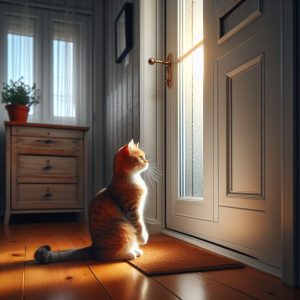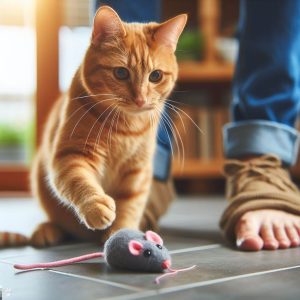Have you ever noticed your cat’s nose getting damp or wet when it purrs? This common feline behavior often puzzles cat owners, but it’s actually perfectly normal and healthy. Understanding the reasons behind this phenomenon will help you appreciate yet another one of your cat’s intriguing quirks.
A Look at Feline Noses
A cat’s nose contains a set of nasal glands that produce mucus and other secretions. The nasal glands continuously release small amounts of moisture to keep the nose supple and functioning optimally. Cats also have nasal passages that airflow directly over, providing them an exceptional sense of smell.
When cats purr, the vibrations from this contented vocalization activate the nasal glands and stimulate secretions. As the nasal passages also vibrate, distribution of the fluid is increased. This results in excess moisture accumulating on the surface of the nose.
So while a dripping wet nose may look concerning, keep in mind that it’s simply a byproduct of stimulated nasal glands and accelerated secretion flow. As long as your cat is happily purring away, a damp nose is nothing to worry about!
Why Do Cats’ Noses Get Wet During Purring?
There are a few theories as to why cat noses produce more moisture when purring:
Enhanced Scent Detection
Cats depend heavily on their sense of smell to gather information about their surroundings. The added nasal fluid brought on by purring may help amplify scent molecules and chemical signals. This allows cats to paint an even clearer olfactory picture when relaxed and content.
Distribution of Feline Pheromones
Cats release pheromones from glands around their face, including their nose and lips. When they lick their nose during or after purring, they help spread these pheromones. This sends chemical signals about their positive state of mind. Other cats detect the pheromones, creating a soothing and calm environment.
Communication of Security
In the same vein, wet noses signal to other cats that an area or situation is safe and comfortable. If your cat is happily purring with a damp nose, other felines will pick up on the content and relaxed vibe. This can promote bonding and community among household cats or colonies.
Natural Response to Vibrations
The vibrations of purring physically stimulate the nasal glands, causing excess secretions. So a wet nose may be an inadvertent but harmless response to the rumbling vocalizations. It simply signals that the nasal glands are functioning as they should.
While we can’t know for certain the evolutionary origins of this quirky cat feature, it does provide some benefits for our feline companions. As long as your cat is healthy overall, embrace the wet nose that comes with vigorous purring!
5 Tips for a Healthy Feline Nose
While nasal dampness during purring is normal, you’ll want to keep an eye out for any unhealthy discharge or persistent moisture. Here are some tips for maintaining your cat’s nasal health:
1. Provide fresh, clean water daily
Dehydration can quickly cause drying of the nasal passages. Ensure ample water is always available to support nasal comfort and regular gland secretions.
2. Consider a cat-safe humidifier
Low humidity can dry out nasal membranes. A cat-friendly humidifier can add moisture to the air to ease this. Consult your vet to see if it may be beneficial.
3. Look for signs of illness
Yellow, green, or bloody discharge could indicate a respiratory infection. Sneezing, breathing issues, and loss of appetite are other concerning symptoms. Seek veterinary care if these arise.
4. Avoid irritants
Keep litter boxes clean and limit exposure to smoke, chemicals, and strong scents that may irritate nasal passages. This helps prevent inflammation.
5. Reduce stress
Chronic stress can impact gland and organ function. Ensure your cat feels relaxed and content through play, affection, routine, and cat-appeasing pheromone products as needed.
While some nasal moisture from purring is perfectly fine, abnormal nasal secretions could signal underlying illness. Contact your vet promptly if you notice any odd or excessive discharge. With proactive care and attention, your cat’s nose will stay healthy!
When to Worry About Nasal Discharge
Nasal discharge is normal, but how much is too much? Here are some guidelines on when to contact your vet:
- Discharge is frequent throughout the day, not just while purring
- Liquid is yellow, green, brown, or bloody
- Discharge is thick and mucus-like
- Nostrils are visibly crusted or blocked
- Sneezing, wheezing, or trouble breathing
- Loss of appetite or lethargy
- Foul odor from nose or mouth
Sudden onset of new symptoms, or any discharge persisting over 48 hours warrants a quick vet visit. Upper respiratory infections can become serious if left untreated. It’s better to be safe than sorry!
What Causes Abnormal Nasal Discharge?
Some potential causes of unhealthy nasal secretions include:
- Viral or bacterial infections – Upper respiratory infections are common in cats
- Allergies – Allergens like pollen or dust cause nasal inflammation
- Foreign objects – Objects stuck in nasal passages trigger discharge
- Dental issues – Tooth decay or abscesses can cause nasal swelling
- Facial trauma – Blunt injuries to the nose or teeth
- Polyps or tumors – Abnormal growths in the nasal cavity
- Airborne irritants – Smoke, chemicals, dust
Only veterinary tests can determine the exact cause of your cat’s nasal troubles. Prompt diagnosis and treatment will get your kitty comfortable again!
When to See the Vet
Contact your veterinarian right away if your cat has:
- Green or yellow discharge from one or both nostrils
- Excessive sneezing, wheezing, or audible congestion
- Difficulty breathing or open-mouth breathing
- Completely blocked nostrils
- Blood in nasal discharge
- Loss of appetite for 12-24 hours
- Extreme lethargy or weakness
- Foul odor from mouth
Quick intervention can help prevent a minor issue from turning into something more serious like pneumonia. Don’t hesitate to call your vet with any nasal concerns!
Diagnosing Cat Nasal and Respiratory Issues
Your vet will begin with a physical exam, checking vital signs, listening to breathing sounds, and assessing nasal passages. They may also utilize tests like:
- Nasal flush – Flushing the nasal cavity to collect a sample
- Rhinoscopy – Inserting an endoscope into the nasal passages
- Radiographs – X-rays to examine nasal structures
- CT scan – Advanced imaging for detailed views
- Biopsy – Taking a tissue sample for lab testing
- Bacterial culture – Testing discharge for infectious organisms
- Bloodwork – Checking for signs of infection or inflammation
Based on symptoms and test results, your vet will determine the cause and prescribe appropriate treatment. This may include antibiotics, anti-inflammatories, or medication to dilate nasal passages.
5 Tips to Prevent Feline Nasal and Respiratory Problems
You can help reduce nasal irritation and respiratory infections in your cat by:
- Keeping litter boxes extremely clean to avoid dust and odors
- Using dust-free, low-tracking cat litter
- Limiting exposure to smoke and other air pollutants
- Keeping your cat indoors to reduce contact with contagions
- Avoiding the use of harsh cleaners, sprays, and scented products
- Maintaining humidity between 30-50%
- Grooming facial fur regularly to prevent discharge accumulation
A little prevention goes a long way in supporting your cat’s nasal health and comfort!
How to Treat a Cat With Nasal Congestion at Home
For mild nasal discomfort, try these at-home remedies while monitoring your cat’s symptoms:
- Facial steam: Hold your cat comfortingly and let them breathe naturally rising steam from a bowl of hot (not boiling) water. Do this for 10 minutes, 2-3 times per day.
- Hydration: Increase fresh water intake to loosen mucus. Consider adding tuna juice or low-sodium broth to water to entice drinking.
- Humidity: Use a cat-safe humidifier to ease congestion by adding moisture to the air.
- Saline spray: Gently flush nasal passages with a cat saline spray to provide relief by removing discharge.
- Gentle wipe: If tolerated, use a soft cloth moistened with warm water to gently wipe away excess mucus on the nose.
- Massage: Lightly massage around the nose and sinus area to provide comfort and stimulate drainage.
- Rest: Allow extra naps and limit activity to avoid exacerbating stuffiness.
Always call your vet if symptoms persist beyond 2-3 days or seem to worsen. Home remedies help provide temporary relief in mild cases only.
When to Take Your Cat to the Emergency Vet
In certain situations, a trip to the emergency vet is warranted. Seek emergency care if your cat has:
- Sudden inability to breathe through nose, gasping for air
- Blue-tinged gums or tongue
- Collapse or loss of consciousness
- Extreme lethargy, unable to stand
- High fever above 104°F (40°C)
- Copious bloody nasal discharge
- Recent facial trauma
- Persistent violent sneezing
- Signs of dehydration – dry gums, sunken eyes
- Seizures
If your cat stops breathing or seems near respiratory failure, perform rescue breaths during transport. Trouble breathing is a medical emergency requiring immediate veterinary intervention.
FAQs About Cat Nasal Discharge
Is it normal for my cat’s nose to run sometimes?
Yes, it’s normal for a small amount of clear discharge to moisten the nose and help trap dust. As long as their nose doesn’t constantly run, it’s nothing to worry about.
What if my cat’s nose is always dripping?
Frequent dripping or discharge points to an underlying issue. Excess mucus is the body’s way of trying to flush out irritants or germs. Have your vet examine your cat to determine the cause.
Why does my cat’s nose run after eating?
In some cats, eating can stimulate low-grade allergies or irritants that trigger post-meal nasal secretions. Discuss options with your vet if this occurs regularly.
Should I wipe my cat’s runny nose?
You can gently wipe away excess discharge around nostrils with a warm, wet cloth. But avoid inserting anything into the nasal passages. Consult your vet before administering nasal medications.
Is it bad if my cat’s nostrils are always crusted?
Persistent crusty buildup indicates chronic nasal irritation. See your vet to discover the source of inflammation. Leaving thick mucus in the nose can increase discomfort and infection risk.
The Takeaway on Cat Nasal Discharge
While a wet nose during purring is perfectly normal, significant nasal discharge merits an exam. Respiratory infections require prompt veterinary diagnosis and treatment. With attentive care of your cat’s unique feline features, you’ll be rewarded with years of healthy purring!



